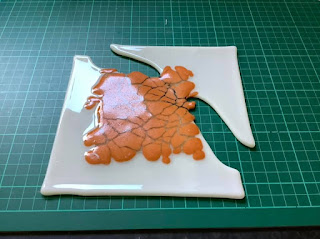Many novice kilnformers tend toward the use of tack rather than full fusing in their work. This is a bit perplexing, as tack fusing is more difficult than full fusing to complete successfully.
Why is tack fusing more difficult?
The single most important reason is that the pieces of glass on top of the base shade the heat from the area underneath. And they do that unevenly over the base glass. Additionally, the tacked pieces are not fully incorporated into the base and so tend to behave as separate pieces, especially on angular tack fusing. Both these factors require greater thought and care in scheduling.
Evidence
The evidence for the statement that tack fusing is more difficult than full comes from several areas.
There is a lot of evidence on social media of failed tack fused projects. It may be argued that it is natural for the difficulties to be highlighted on the self-help groups. And the successes are not so widely shared. There are other pieces of evidence.
Breaks of base sheet while the overlaying pieces remain intact.
This is a result of the overlaying glass shading the heat from the lower layers. Some writers describe the effect as glass “seeing” heat. The glass reacts more quickly to radiant heat than to transmitted heat from the air. As a result, the glass exposed to the radiant heat absorbs heat more easily than the shaded areas. This leads to uneven heating during the rise in temperature and a build-up of stress which frequently causes breaks from expansion differences in the base glass.
Breaks along the borders of the thick and thin areas of pieces are common in tack fusing.
This usually occurs during the cooling. Thick and thin areas take different amounts of time to release the stored heat. As in heat up, if the temperature differential is too great, the glass will break. Research by Bullseye has shown that significant stress can be built up by temperature differences greater than 5°C across the piece. What temperature difference is required to develop enough stress to cause a piece to break is unknown, although it does relate to the degree of variation in thicknesses and areas of base covered.
Scheduling as for thicker pieces.
Further evidence is given by several sources stating that tack fusing projects need to be scheduled as though between 1.5 and 2.5 times the actual thickness to be successful. This need for more careful firing is supported by the success of this strategy which increases the heat work as applied to tack fusing.
Further information is available in the ebook Low Temperature Kiln Forming.
Tack fusing requires more care than flat fusing because of heat shading and thickness differences. There are some scheduling approaches that can minimise the risks of breakage.

No comments:
Post a Comment